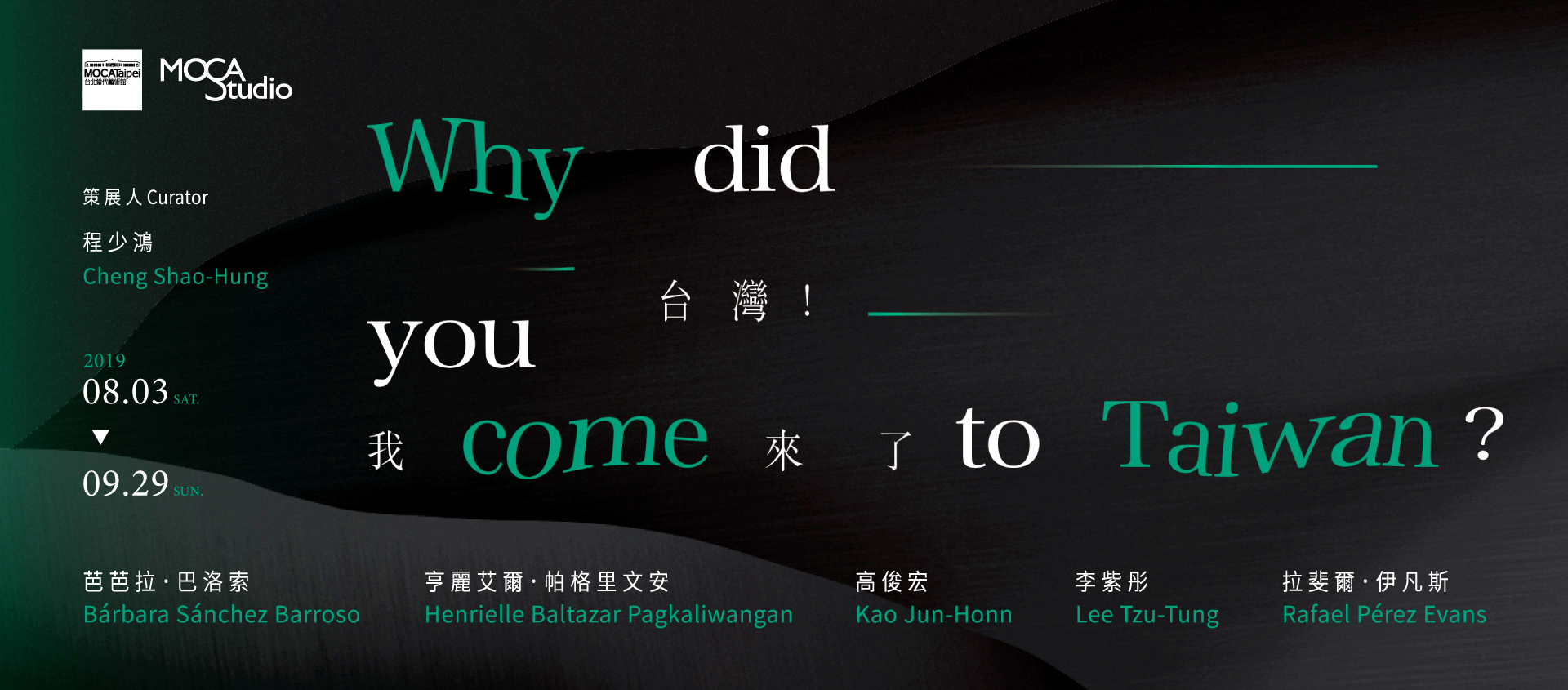

台北當代藝術館 官方網站 Museum of Contemporary Art, Taipei
Sunday 星期日
10AM - 6PM



Sunday 星期日
10AM - 6PM
EXHIBITIONS & EVENTS 展覽活動

2019 / 08 / 03 Sat.
2019 / 09 / 29 Sun.
10:00 - 18:00
地點
VENUE
MoCA Studio
策展人|程少鴻
展覽靈感來自一名短暫來台,中介於荷蘭與西班牙等多方勢力的人物薩爾瓦多.迪亞茲(Salvador Díaz)。迪亞茲被荷蘭人俘虜來台當作翻譯,在台期間透過竊取商船情報,販賣給海盜和向中國商人收取保護費,並且在逃出台灣後,將荷蘭基地的佈署交給葡萄牙與西班牙人。這個展覽對迪亞茲提出「你為什麼來到台灣?」的問題,藉此引出殖民者與被殖民者之間複雜交錯的身分關係。
學者陳光興指出,被殖民者的去殖民工作,必須與殖民者的去帝國運動配合才有進行的可能,展覽從這個設定出發,以藝術的平台做為台灣解殖的實驗場域。考量歷史對應的當代政治現況,就可行性與議題的擴散性,鎖定西班牙在台灣的殖民史做為這個實驗的開端。展覽於是成為一個「沙盒」(Sandbox),在這當中被殖民者與殖民者彼此面對自己的歷史,合作進行去殖民與去帝國的工作。然而,沙盒建立的真正目的是要以此作為引線,觸及台灣近代難以言說的殖民、國族以及族群認同問題。
此次參展的外籍藝術家首次接觸台灣被殖民的歷史,他們以現地製作的作品做出回應。西班牙威爾斯裔藝術家拉斐爾.伊凡斯的《魔鬼之鳥,鳥占術》以虛擬實境的技術帶領觀眾回探西班牙傳教士與台灣原住民傳統信仰的相遇。另一位西班牙藝術家芭芭拉.巴洛索《遙遠的福爾摩沙》邀請菲律賓籍移工擔任台北城市漫遊的嚮導,回應自十七世紀以來西班牙和台灣一脈相承的勞力輸入策略造成的跨國族群移動與城市文化變遷。菲律賓藝術家亨麗艾爾.帕格里文安《後–謨區查抄本》描繪西班牙化的菲律賓生活用品、生產工具與宗教器物,反映殖民與文化融合的關係,並做為十七世紀因西班牙殖民來台的菲律賓原住民的替代歷史(alternative history)。
參展的兩位台灣藝術家均透過田野,以及虛實交錯的紀錄片形式構成敘事。高俊宏《丁修女–但是我們從來不會去西班牙傳教》以鬼魂探測、觀落陰和口述歷史的方式挖掘十七世紀至今,西班牙人在台灣的傳教軼事,思考和帝國擴張行動並行的精神志業如何在台灣開啟與延續。李紫彤《時差書寫》以原住民部落及女性個人史,作為穿越族群認同與歷史書寫權威的方式,藝術家除了面對外部的影響,也從在地族群內部尋找解殖的路徑。
Curator|Cheng Shao-Hung
This exhibition was inspired by Salvador Díaz, who was an intermediary between Dutch and Spanish forces during his short stay in Taiwan. Captured by the Dutch to serve as a translator in Taiwan, Díaz would steal intelligence pertaining mercantile ships in his time here, selling them to marauders or extorting protection fees from Chinese merchants. After escaping Taiwan, he delivered the layout of the Dutch base to the Portuguese and Spanish. This exhibition takes Díaz’s comment, “Why did you come to Taiwan?”, as the catalyst to explore the intersecting identities between colonizer and colonized.
Scholar Chen Kuan-Hsing remarks that for the grand undertaking of de-colonization by the colonized to be possible, it must correspond to de-imperialization movements of the colonizer. With this as a starting point, this exhibition treats the platform of art as an experimental site for Taiwanese decolonization. Considering the juxtaposition of contemporary politics with history, the aim of this project is to focus on Spain’s colonial history in Taiwan, as a basis of possibility and to expand coverage of key topics. The exhibition thus becomes a “Sandbox”, within which the colonizer and colonized each confront their own histories, and collaborate in the joint endeavor of de-colonization and de-imperialization. Nevertheless, the real intent of establishing this sandbox is also for it act as a lit fuse, to encroach upon the prickly issues of colonization, nationalism, and ethnic identity in present-day Taiwan.
This exhibition is the first encounter by these foreign artists with Taiwan’s history of colonialism, and they have each produced site-specific works as a response. The Devil’s Bird, Ornithomancy, by Spanish-Welsh artist Rafael Pérez Evans, escorts audiences back to the earliest confrontations between Spanish missionaries and traditional aborigines faith by way of VR technology. Far from Formosa by Bárbara Sánchez Barroso, another artist from Spain, invites Filipino migrant workers to serve as guides for a city tour of Taipei, responding to the strategic influx of labor for Spain in the 17th century—and in the same vein modern Taiwan—that resulted in trans-national migrations and transformations in urban culture. Filipino artist Henrielle Baltazar Pagkaliwangan’s Beyond the Boxer Codex illustrates the influence of Spain on basic commodities, production tool, and religious items in the Philippines, not only reflecting upon the relationship of colonialism and cultural integration, but also as an alternative history for 17th century indigenous Filipinos who arrived in Taiwan due to Spanish colonization.
The two Taiwanese artists taking part in this exhibition both constructed narratives out of their field research and documentaries that weave fiction and reality. In Kao Jun-Honn’s Sister Ding–But We Never Preach in Spain, from the 17th century up to the present, anecdotes of Spanish missionaries to Taiwan are uncovered through paranormal detection, Taoist ritual, and oral history, furthermore contemplating how the counter-consciousness taking place in parallel to imperialist expansion can be adopted in Taiwan. Lee Tzu-Tung’s Writing the Time Lag takes the aboriginal tribe and a woman’s personal history as the impetus to traverse ethnic identity and the authoritative position of historical writing, not only confronting the impact of external forces, but also seeking a path towards decolonization from within the local community.
MORE
LESS
西班牙藝術家芭芭拉.巴洛索現居比利時,創作實踐以錄像及裝置為主。巴洛索在影視、藝術及文學方面的探索,透露出研究、書籍及電影在其創作中的重要性,作品關注個人生命脆弱中隱含的政治面向、敘事的力量,及自身生活中偶然而遇的未知故事。
Born in Spain and currently living in Belgium, Bárbara Sánchez Barroso’s art practice focuses on video art and installation. The importance of research, books, and cinema to her work can clearly be seen in her exploration of the audiovisual, the arts, and literature, concerning the political dimensions of the personal and vulnerability, the power of narrative, and stories, still yet unknown, to be encountered within the routines of her own life.
亨麗艾爾.帕格里文安目前於菲律賓甲米地居住及創作,作品靈感源自於自然歷史插圖中固有的構圖及美學元素,藉此探索世俗及不可或缺的物件背後隱藏的敘事,進而檢視人類歷史及物質文化。
Henrielle Baltazar Pagkaliwangan currently resides and works in Cavite, Philippines. The inspiration for her work draws on the composition and aesthetic elements intrinsic to natural history illustrations, through which she explores the hidden narratives behind both our mundane and essential objects, in turn scrutinizing the history of humankind and material culture.
高俊宏為藝術行動者,台南藝術大學創作理論研究所博士,台北藝術大學藝術跨域研究所兼任助理教授。近年的藝術實踐,從東亞藝術行動者的考察、《廢墟影像晶體計畫》、北台灣衛星城鎮地帶的拍攝作品《博愛》、關於近代台灣山林的《橫斷記》,到《大豹》計畫,其作品關注議題圍繞著歷史與諸眾、原民性與生命政治。
Art-activist Kao Jun-Honn, who received his doctorate in Art Creation and Theory at the Tainan National University of the Arts, is an assistant professor for the Graduate Institute of Trans-disciplinary Arts at the Taipei National University of the Arts. His recent art practices include a survey of art-activism in East Asia, from The Ruin Image Crystal Project, the photo series Bo'ai (Universal Love) of satellite towns in northern Taiwan, his volume on contemporary Taiwan mountain-forests in Notes on Traversing: Mountain Warfare, Empire and Images of Taiwan, to the Ncaq project, his artwork invariably addresses the topics of history and the people, of indigeneity and the politics of life.
李紫彤為台灣藝術家、導演,關注性別、政治、原住民、白色恐怖、國族認同等議題,多以新媒體進行參與式創作。
Lee Tzu-Tung is a Taiwanese artist and director, focused on the topics of gender, politics, indigenous people, the White Terror, and national identity, typically creating participatory artwork through new media.
西班牙威爾斯裔當代藝術家拉斐爾.伊凡斯現居住並工作於倫敦,他的創作以裝置為工具,探索知識系統、人種誌及思想進程相關的問題。透過創造性的方式運用現成物、有機物質及觀眾參與等元素,伊凡斯操演著魔幻的語言,進行施咒、再消解,並將各種故事重啟於訊息傳播的系統之中,藉此開啟一個詩意錯亂的疆域,重新導引我們看見鄉土、殖民的遺緒及異己的力量。
Rafael Pérez Evans is a Spanish-Welsh contemporary artist based in London. His installations function as tools for exploring questions around knowledge systems, ethnographies and ideas around progress. Through his inventive use of readymades, live materials and audience participation, Evans plays with the language of magic to conjure, redigest and expel stories back into news circulation. With this occupying a territory where poetic disorientations, can redirect us towards the rural, the leftovers of coloniality and the forces of alterity.
CLOSE
CLOSE
著作權聲明
台北當代藝術館尊重他人著作權,台北當代藝術館服務條款亦明定,網友使用台北當代藝術館服務不得侵害他人之著作權,因此,台北當代藝術館呼籲使用者同樣尊重他人之著作權。如果您認為台北當代藝術館網站中之任何網頁內容或網友使用台北當代藝術館服務已侵害您的著作權,建議您利用本處理辦法提出檢舉,台北當代藝術館客服中心將儘速為您處理:
若台北當代藝術館網站中之任何網頁內容或網友使用台北當代藝術館服務已侵害您的著作權,請您填寫:「 著作權侵權通知書」,且依該通知書所載提供下列資料及聲明,並以傳真的方式通知台北當代藝術館:
1、著作權人之簽名、或著作權人之代理人之簽名、相關權利證明文件及著作權之內容,例如:已發行書籍之封面及相關頁面、發表於網路中之網頁內容列印紙本及其網址。
2、侵害著作權之內容所在的網頁及網址。
3、您的聯絡地址、電話等資料。
4、書面聲明您確信該網頁內容的使用行為是未經過著作權人、其代理人或法律的授權。
5、書面聲明您於通知書所載相關資料均為真實,且您是著作權人或著作權人之代理人而為上開聲明。
若台北當代藝術館網站中之任何網頁內容或網友使用台北當代藝術館服務已侵害您的著作權,請您填寫:「 著作權侵權通知書」,且依該通知書所載提供下列資料及聲明,並以傳真的方式通知台北當代藝術館:
1、著作權人之簽名、或著作權人之代理人之簽名、相關權利證明文件及著作權之內容,例如:已發行書籍之封面及相關頁面、發表於網路中之網頁內容列印紙本及其網址。
2、侵害著作權之內容所在的網頁及網址。
3、您的聯絡地址、電話等資料。
4、書面聲明您確信該網頁內容的使用行為是未經過著作權人、其代理人或法律的授權。
5、書面聲明您於通知書所載相關資料均為真實,且您是著作權人或著作權人之代理人而為上開聲明。
隱私權保護政策
台北當代藝術館非常重視用戶的隱私權,因此制訂了隱私權保護政策。請你細讀以下有關隱私權保護政策的內容。
隱私權保護政策的適用範圍
1、隱私權保護政策內容,包括台北當代藝術館如何處理在用戶使用網站服務時收集到的身份識別資料,也包括台北當代藝術館如何處理在商業伙伴與台北當代藝術館合作時分享的任何身份識別資料。
2、隱私權保護政策不適用於台北當代藝術館以外的公司,也不適用於非台北當代藝術館所僱用或管理的人員。
3、台北當代藝術館在你註冊台北當代藝術館帳號、使用台北當代藝術館的產品或服務、瀏覽台北當代藝術館網頁、參加宣傳活動或贈獎遊戲時,台北當代藝術館會收集你的個人識別資料。台北當代藝術館也可以從商業夥伴處取得個人資料。
4、當你在台北當代藝術館註冊時,我們會問及你的姓名、電子郵件地址、出生日期、性別、職位、行業及個人興趣等資料。你在台北當代藝術館註冊成功,並登入使用我們的服務後,我們就會認識你。
5、台北當代藝術館也自動接收並紀錄你瀏覽器上的伺服器數值,包括互聯網協定位址 (IP Address) 、台北當代藝術館cookie中的資料及你要求取用的網頁紀錄。
6、台北當代藝術館會使用資料作以下用途:改進為你提供的廣告及網頁內容、完成你對某項產品的要求及通知你特別活動或新產品。
7、台北當代藝術館不會向任何人出售或出借你的個人識別資料。
8、在以下的情況下,台北當代藝術館會向政府機關、其他人士或公司提供你的個人識別資料:與其他人士或公司共用資料前取得你的同意。
9、需要與其他人士或公司共用你的資料,才能夠提供你要求的產品或服務。
10、向代表台北當代藝術館提供服務或產品的公司提供資料,以便向你提供產品或服務 (若我們沒有事先通知你,這些公司均無權使用我們提供的個人資料,作提供產品或服務以外的其他用途)。
11、應遵守法令或政府機關的要求。
12、我們發覺你在網站上的行為違反 台北當代藝術館服務條款或產品、服務的特定使用指南。
13、其他依「個人資料保護法」或政府法令應公開之資料。
14、為了保護使用者個人隱私, 我們無法為您查詢其他使用者的帳號資料,請您見諒!若您有相關法律上問題需查閱他人資料時,請務必向警政單位提出告訴,我們將全力配合警政單位調查並提供所有相關資料,以協助調查及破案!
15、 台北當代藝術館會到你的電腦設定並取用台北當代藝術館cookie。
16、台北當代藝術館容許在我們網頁上擺放廣告的廠商到你的電腦設定並取用cookie。其他公司將根據其自訂的隱私權保護政策,而並非本政策使用其cookie。其他廣告商或公司不能提取台北當代藝術館的cookie。
17、當台北當代藝術館進行與其產品及服務有關的工作時,會使用 web beacons 進入我們的網站網絡,提取cookie使用。
18、台北當代藝術館賦予你在任何時候修改個人台北當代藝術館帳號資料及偏好設定的權力,包括接受台北當代藝術館通知你特別活動或新產品的決定權。